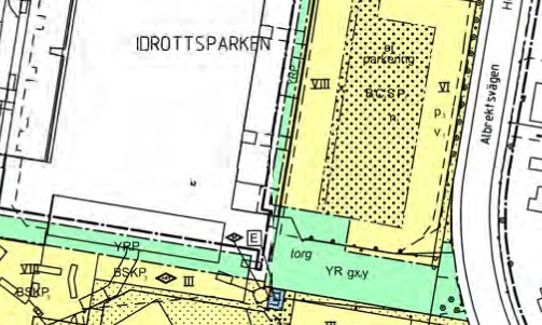A new residential area, at Idrottsparken sports park, is growing forth in central Norrköping. Apartment blocks and elderly housing are being built in a former green area comprising 1.5 hectares. The detailed development plan and an overall storm water run-off study were completed in 2011. The municipal water utility, Norrköping Vatten och Avfall, was not brought in until 2013 to resolve the storm water run-off handling in the area.
Compensation for lost green space
The area was converted from green space to streets, residential buildings and a ground-level garage with a courtyard built over. This development meant a loss of infiltration possibilities for storm water run-off and the company’s assignment was therefore to design a compensation solution for the green spaces that were removed.
The solution could not entail a further burden on the already heavily burdened networks in the surroundings and no space above ground was available. The choice was made to build a retention reservoir underground. The reservoir was deemed to need to accept 470 m³ of rain water. The dimensioning was based on a rain with a 20-year recurrence period with an additional margin of 25%, as compensation for greater precipitation in the future climate.
Storm water infiltration cassettes and pipes
The area below the courtyard parking area was used for the installation of the storm water cassettes and a local road was used for the infiltration pipe. The solution with a retention reservoir was considered to be an area-efficient solution that fit the needs of the site.

The cassette reservoir is built up of multiple smaller modules similar to plastic crates and its size was adapted to the available area. Rain water is gathered from street drains from the road and from the area around the buildings through regular pipes. In short, normal rains, no retention occurs, but it occurs when the pipes are filled and thereby dammed.
A plan for operation and maintenance has been prepared and the operational managers were represented during the planning phase.
Costs
Materials and labour costs for the infiltration pipe amounted to SEK 2.5 million and the equivalent for the storm water cassettes was around SEK 1.5 million.
Financing
The project was included in the company’s ordinary activities, which are paid by the water and sanitation collective, and did not affect the storm water tariff. The developer’s land agreement was finished when the project began, which meant that the cost rested entirely with Norrköping Vatten och Avfall.
More examples of climate adaptation
This is one of many examples of climate adaptation. There are more in the collection of ideas being built up by the Swedish National Knowledge Centre for Climate Change Adaptation at the Swedish Meteorological and Hydrological Institute (SMHI). The collection of examples has the aim of sharing experiences and providing ideas to everyone who works with climate adaptation. Examples describe concrete measures and challenges in several subject areas. They show how different actors have worked to adapt their activities to the climate changes that are already being noticed today and those that we cannot prevent in the future.